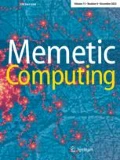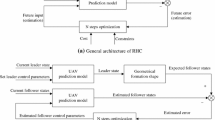Abstract
Close formation flight of swarm unmanned aerial vehicles (UAVs) has drawn much attention from scholars due to its significant importance in many aspects. In this paper, we focus on an advanced controller design for swarm UAV close formation based on a novel bio-inspired algorithm, i.e., metric-distance brain storm optimization (MDBSO). The proposed method utilizes the brain storm optimization (BSO) which has been extensively adopted in complicated systems with great performances and modifies its basic operators to formulate the formation flight controller design. The original clustering operator in BSO is replaced by a fresh clustering method based on metric distances, while the individual updating operator utilizes Lévy distribution to extend search steps to fit into the metric searching regions. Then the proposed algorithm is applied to optimize the benchmark controller in swarm UAV close formation to enhance the tracking performances under complicated circumstances. Simulation results demonstrate that our approach is more superior in stable configuration of swarm UAV close formations by comparing with several generic methods.








Similar content being viewed by others
References
Karimoddini A, Hai L, Chen BM, Lee TH (2013) A bumpless hybrid supervisory control algorithm for the formation of unmanned helicopters. Mechatronics 23(6):677–688
Weimerskirch H, Martin J, Clerquin Y et al (2001) Energy saving in flight formation. Nature 413(6857):697–698
Ray R, Cobleigh B, Vachon MJ, John CS (2002) Flight test techniques used to evaluate performance benefits during formation flight. In: AIAA atmospheric flight mechanics conference and exhibit, Monterey, California, 5–8 August, https://doi.org/10.2514/6.2002-4492
Proud AW, Pachter M, D’Azzo JJ (1999) Close formation flight control. In: AIAA guidance, navigation, and control conference and exhibit, Portland, 9-11 August, pp 1231–1246
Wagner MG, Jacques LD, Blake W, Pachter M (2002) Flight test results of close formation flight for fuel savings. In: AIAA atmospheric flight mechanics conference and exhibit, Monterey, California, 5–8 August, https://doi.org/10.2514/6.2002-4490
Zhang Q, Liu Hugh HT (2016) Robust design of close formation flight control via uncertainty and disturbance estimator. In: AIAA guidance, navigation, and control conference, San Diego, California, 4–8 January, https://doi.org/10.2514/6.2016-2102
Johnson Y, Dasgupta S (2014) Robust controller design and performance of forward-velocity dynamics of UAVs in close formation flight. In: IEEE international conference on advances in green energy, Trivandrum, Kerala, India, 17–18 December, pp 124–131
Palacios L, Ceriotti M, Radice G (2015) Close proximity formation flying via linear quadratic tracking controller and artificial potential function. Adv Space Res 56(10):2167–2176
Lalwani S, Kumar R, Gupta N (2015) A novel two-level particle swarm optimization approach for efficient multiple sequence alignment. Memet Comput 7(2):119–133
Xin L, Xian N (2017) Biological object recognition approach using space variant resolution and pigeon-inspired optimization for UAV. Sci China Technol Sci 60(10):1577–1584
Pei J, Su Y, Zhang D (2017) Fuzzy energy management strategy for parallel HEV based on pigeon-inspired optimization algorithm. Sci China Technol Sci 60(3):425–433
Dou R, Duan H (2017) Lévy flight based pigeon-inspired optimization for control parameters optimization in automatic carrier landing system. Aerosp Sci Technol 61:11–20
Mininno E, Neri F (2010) A memetic differential evolution approach in noisy optimization. Memet Comput 2:111–135
Shi Y (2011) Brain storm optimization algorithm. In: International conference on swarm intelligence, Chongqing, China, 12–15 June, pp 303–309
Zhou Z, Duan H, Shi Y (2016) Convergence analysis of brain storm optimization algorithm. In: IEEE congress on evolutionary computation, Vancouver, Canada, 24–29 July, pp 3747–3752
Zhan Z, Chen W, Lin Y et al. (2013) Parameter investigation in brain storm optimization, In: IEEE symposium on swarm intelligence, Singapore, 16–19 April, pp 103–110
Cheng S, Shi Y, Qin Q et al. (2014) Maintaining population diversity in brain storm optimization algorithm, In: IEEE congress on evolutionary computation, Beijing, China, 6–11 July, pp 3230–3237
Qiu H, Duan H (2014) Receding horizon control for multiple UAV formation flight based on modified brain storm optimization. Nonlinear Dyn 78(3):1973–1988
Sun C, Duan H, Shi Y (2013) Optimal satellite formation reconfiguration based on closed-loop brain storm optimization. IEEE Comput Intell Mag 8(4):39–51
Cheng S, Qin Q, Chen J, Shi Y (2016) Brain storm optimization algorithm: a review. Artif Intell Rev 46:445–458
Cheng S, Shi S, Qin Q, Gao S (2013) Solution clustering analysis in brain storm optimization algorithm. In: IEEE symposium on swarm intelligence, Singapore, 16–19 April, pp 111–118
Ballerini M, Cabibbo N, Candelier R et al (2008) Interaction ruling animal collective behavior depends on topological rather than metric distance: evidence from a field study. Proc Natl Acad Sci USA 105(4):1232–1237
Niizato T, Gunji Y (2011) Metric-topological interaction model of collective behavior. Ecol Model 222:3041–3049
Sakamoto Y, Takahashi T (2014) Metric and topological neighborhoods in flocking models. In: International conference on bioinspired information and communications technologies, Boston, 1–3 December, pp 118–121
Niizato T, Murakami H, Gunji Y (2014) Emergence of the scale-invariant proportion in a flock from the metric-topological interaction. Biosystems 119:62–68
Shang Y, Bouffanais R (2014) Consensus reaching in swarms ruled by a hybrid metric-topological distance. Eur Phys J B 87(12):294
Eliazar I (2014) A geometric theory for Levy distributions. Ann Phys 347:261–286
Acknowledgements
This work was partially supported by National Natural Science Foundation of China under Grants #61425008, #61333004 and #91648205, Aeronautical Foundation of China under Grant #2015ZA51013, and Shenzhen Science and Technology Innovation Committee under Grant # ZDSYS201703031748284.
Author information
Authors and Affiliations
Corresponding author
Rights and permissions
About this article
Cite this article
Duan, H., Zhang, D., Shi, Y. et al. Close formation flight of swarm unmanned aerial vehicles via metric-distance brain storm optimization. Memetic Comp. 10, 369–381 (2018). https://doi.org/10.1007/s12293-018-0251-z
Received:
Accepted:
Published:
Issue Date:
DOI: https://doi.org/10.1007/s12293-018-0251-z



